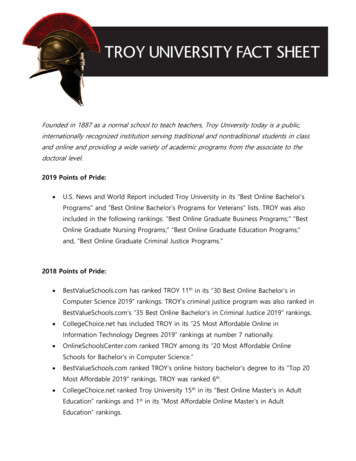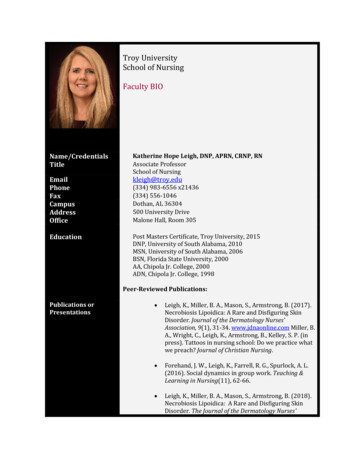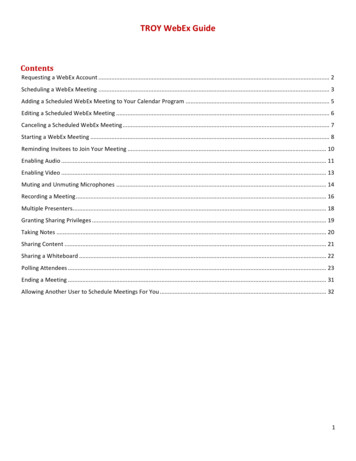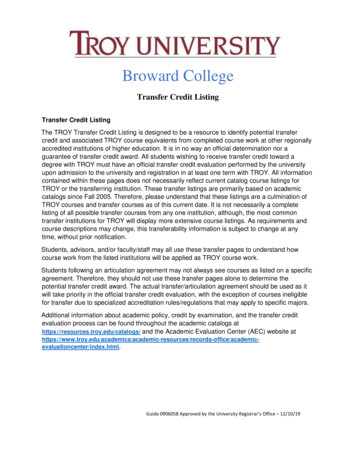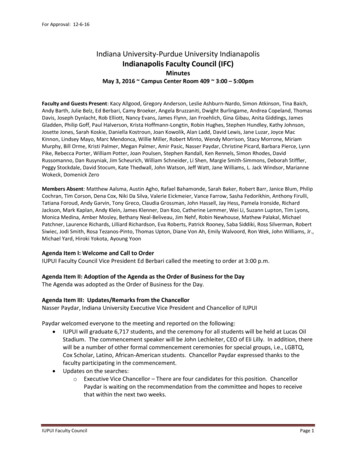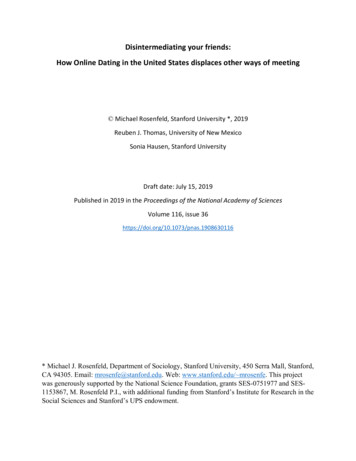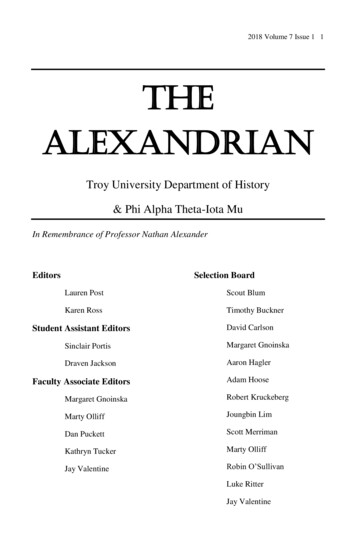
Transcription
2018 Volume 7 Issue 1 1TheAlexandrianTroy University Department of History& Phi Alpha Theta-Iota MuIn Remembrance of Professor Nathan AlexanderEditorsSelection BoardLauren PostScout BlumKaren RossTimothy BucknerStudent Assistant EditorsDavid CarlsonSinclair PortisMargaret GnoinskaDraven JacksonAaron HaglerFaculty Associate EditorsAdam HooseMargaret GnoinskaRobert KruckebergMarty OlliffJoungbin LimDan PuckettScott MerrimanKathryn TuckerMarty OlliffJay ValentineRobin O’SullivanLuke RitterJay Valentine
2 The AlexandrianAlexandrian Submission GuidelinesThe Alexandrian accepts manuscripts pertaining to the subjects of historyand philosophy. Accepted forms include book reviews, historiographicessays, and full-length articles.Format: All submissions should be in Microsoft Word. They shouldadhere to the Chicago Manual of Style. Please include footnotes instead ofendnotes and refrain from using headers.Abstract: Any article submission must include an abstract of no more than200 words. This is not necessary for submissions of book reviews oressays.Author biography: A short biography of any relevant information shouldbe included for the contributors’ page of the journal. Such informationincludes your major and class designation, graduation date, researchinterests, plans after college, hometown, any academic honors ofaffiliations you deem relevant, etc. Author biographies should be no morethan 100 words. Please be sure your name is written as you would like itto appear in the journal.Please send all submissions to Dr. Karen Ross at kdross@troy.edu.Cover Art: Our cover art, Portrait of Linda Brown, was created by TaylorMetcalf, a graphic design major at Troy University. Taylor is a junior fromPanama City Beach, Florida. Linda Brown (1943-2018) was the Kansasschoolchild at the heart of the 1954 Brown v. Board of Education SupremeCourt decision that signaled the end of racial segregation in public schools.
2018 Volume 7 Issue 1 3TheAlexandrianTable of ContentsContributors’ Biographies .4ArticlesThe Conflict between Medical Science, Public Health, and theAntivaccination Movement in Nineteenth Century England, AbenaAdaboh . . .7Black Educators after Brown vs. Board of Education, Christopher E.Anderson. . 26The Atlanta Jewish Committee: Collaboration in the Face of Difference,Leilani Harris .42Navigating Intellectual and Traditional Crossroads: Plotinus, SethianGnostics, and Early Trinitarians, Benjamin Hatfield. . . 70Not Fake News: The New York Times and Senator Joseph McCarthy,Ansley Markwell . .83An Organized Inequity, Lauren Post .96The Nuclear Bomb and American Culture: A Historiographical Essay,Nicholas Prenzler . 109Among the Steppes: A Societal Study of the Soviet Past in Kyrgyzstan,Whitney Spake .121Division News . . .153Gratitude . . .155Professor Nathan Alexander Remembered . . .156Phi Alpha Theta Inductees . . 157
4 The AlexandrianContributors’ BiographiesAbena AdabohAbena Adaboh is a senior Troy University with a major in BiomedicalScience and a minor in Philosophy. She is from Ghana but completed herhigh school education in Berrien Springs, Michigan. Abena is a memberof Alpha Epsilon Delta, former Vice President of Beta Beta Beta, formerPresident of the Troy University Women’s Initiative, and formertreasurer of the Troy African Students Association. She hopes to attendmedical school sometime after graduating.Christopher E. AndersonChristopher E. Anderson is a senior at Troy University graduating in thefall of 2018. He is from Dothan, Alabama where he attended DothanHigh School. He also graduated summa cum laude from WallaceCommunity College. At Troy University, Christopher is majoring inAmerican History with a minor in Political Science. He is a member ofPhi Alpha Theta, Student Government Association, NAACP, and TroyUniversity’s Pendulum Performing Arts Society. Upon graduation, Chrisplans to take a year off from school and teach history before pursuing aMaster’s Degree in History with a concentration in intellectual historyand historical consciousness through literature.Leilani HarrisLeilani Harris graduated with a Bachelor of Science in Political Sciencefrom Troy University in 2008. Upon graduation, she received hercommission in the U.S. Army as a Second Lieutenant. Leilani is a 14year veteran now working on her master’s degree in European History.Upon graduation, she intends to work towards her doctorate with aconcentration on World War II and Holocaust history. She is currently amember of the Alabama Association of Historians, the AlabamaHistorical Association, and the Southern Jewish Historical Society.Leilani would like to be a professor when she has completed all of herschooling.
2018 Volume 7 Issue 1 5Benjamin HatfieldBenjamin Hatfield is pursuing a major in Anthropology with a minor inPhilosophy and Religions. He is from Lacey’s Spring, Alabama, andattended A.P. Brewer High School. He is a member of Troy University’sArchaeology Club and has participated in cultural resource managementprojects with the Troy University Archaeological Research Center. Aftergraduation, Benjamin plans on pursuing a graduate degree inanthropology, focusing on archaeology of the Old World.Ansley MarkwellAnsley Markwell is a 2017 magna cum laude graduate of TroyUniversity earning a double bachelor’s in History and Human Serviceswith a minor in English. She is a former editor of The Alexandrian andwas previously published in the Phi Alpha Theta special issue (no. 2) in2017. Ansley served Troy’s history department as the vice president ofthe History Club (2016-2017) and as the vice president of Troy’s PhiAlpha Theta chapter (2016-2017). Ansley currently works at HuntingdonCollege in Montgomery, Alabama, as the Residence Director of LigonHall and the Student Affairs Program Assistant. In the next year, Ansleyplans to begin earning a Master’s degree in history as she furthers hereducation in pursuit of her goal of becoming a history professor.Lauren PostLauren Post is a junior at Troy University in English Literature with aminor in History. She is from Troy, Alabama, where she graduated fromCharles Henderson High School with honors. At Troy, she holdsmemberships in Phi Alpha Theta, Sigma Tau Delta, and Troy’s HistoryClub, is a staff writer for the Tropolitan newspaper, and is co-editor ofThe Alexandrian. During her sophomore and junior years, she workedunder Nancy Dupree at The Alabama Department of Archives andHistory. After graduating, she plans on continuing her studies in English,obtaining master’s degrees in both English and Library Science.
6 The AlexandrianNicholas PrenzlerNicholas Prenzler is a graduate student at Troy University majoring inAmerican History and minoring in European History. He graduated fromThe University of Texas at Austin with Bachelor of Arts degrees inHistory and Government in 2016. He also completed the BusinessFoundations Program at the McCombs School of Business at UT-Austin.Nicholas interned in both the Texas Senate and Texas House ofRepresentatives, where he conducted research for a member of the HousePublic Health Committee. After graduation, Nicholas plans to teachhistory at the college level.Whitney SpakeWhitney Spake graduated from Troy University in December 2017 withher degree in History and a minor in Classics. While at Troy University,Whitney was a member of Phi Alpha Theta, Scholarship Chair of AlphaDelta Pi, and Vice President of Eta Sigma Phi. During her time at Troy,Whitney also presented at the Phi Alpha Theta National Conference(2018), the Phi Alpha Theta Regional Conference (2017), and the TroyUniversity Student Research Conference (2017). She is currently takingan Armenian language course and will move to Armenia as a PeaceCorps TEFL volunteer in March 2018.
2018 Volume 7 Issue 1 7The Conflict Between Medical Science, Public Health, and theAntivaccination Movement in Nineteenth Century EnglandAbena AdabohAbstract: “The Conflict between Medical Science, Public Health and theAntivaccination Movement in Nineteenth Century England” examines theevolution of medical opposition to vaccination from the discovery of the vaccinein the late 18th century until the end of the 19th century. It analyzes how the natureof the vaccine debate was influenced by laws that mandated the vaccination ofinfants. This paper argues that many of the anti-vaccine claims were engenderedby the lack of understanding of disease causality and immunity and amisinterpretation of statistical data. Some antivaccinationists arguments weregroundless while others were legitimate concerns based on sound observations. Itwas only after several improvements to the system of vaccination and thedevelopment of the germ theory that anti-vaccine claims could be completelyrefuted.In 1840, the British Parliament passed the first of a series of Acts that madesmallpox vaccination mandatory and led to the rise of an anti-vaccinationmovement. Leicester was a strong hold of anti-vaccinationists during theVictorian era. In 1883, only 1,732 out of 4,819 infants had been vaccinatedin the city.1 This willful neglect by the parents of the unvaccinated infantscaused the local courts to issue more than 6,000 summons, sixty-fourimprisonments and about 2,500 in fines and led to the loss of 200 homes(sold to cover arrears).2 On March 23, 1885, anti-vaccinationists held alarge demonstration in Leicester that attracted thousands of people fromacross the country.3 They protested the compulsion of the Acts, which theyfelt invaded their personal liberties and the stringency of the punishmentsincurred by violators.4 Both young and old repeated slogans and heldbanners that included phrases such as “entire repeal not compromise,”1J. T. Biggs, Leicester: sanitation versus vaccination: its vital statistics compared with those ofother towns, the army, navy, Japan and England and Wales (London: The National AntiVaccination League, 1912), 101.2Ibid.3Ibid.4Ibid., 106.
8 The Alexandrian“better a felon’s cell than a poisoned babe” and “sanitation notvaccination.”5 In excerpts from the periodical, Vaccination Inquirer, thefollowing description was given of the scene:From half the counties of England, from scores of towns and cities, menof all professions, of all trades, bound in close bonds of sympathy not bytens and twenties, but by hundreds and thousands met Aprocession of ‘law-breakers,’ without a single policeman in ranks tokeep order; and at the end of the day not the rumour of a child knockeddown or a pocket-handkerchief lost!6Guardians, enforcers of the parliamentary Acts, elected in Leicesterfollowing the protests in 1886 were overwhelmingly against compulsoryvaccination.7 The guardians struggled with the local government withoutprogress until 1889, when mounting pressure from anti-vaccinationists allover the country led to the formation of a royal commission to evaluate thevaccination Acts. 8 The smallpox anti-vaccination movement exemplifiedby the Leicester demonstration was a struggle against a radical paradigmshift in scientific thought that changed the practice of medicine andrevolutionized public health. As the movement would reveal, it took morethan just facts to bend the human will or change centuries-old convictions.Overview of SmallpoxTwo strains of the variola virus cause smallpox in humans: variola majorand variola minor. Both are highly contagious, but variola minor has amortality rate of less than one percent while the more prevalent variolamajor has a mortality rate of thirty percent.9 The disease has an incubationperiod of ten to twelve days and is transmitted between people via airbornedroplets.10 Smallpox causes flu like symptoms in the first two to three days5Ibid., 109-110.Ibid., 111Dale L. Ross, "Leicester and The Anti-Vaccination Movement 1853 – 1889," Transactions of theLeicestershire Archaelogical and Historical Society, 43 (1968): 35-44.8Ross, 41.9World Health Organization, "Smallpox," September 21, llpox/en/ (accessed November 19, 2017).10Institute of Medicine (US) Board on Health Promotion and Disease, Scientific Background onSmallpox and Smallpox Vaccination, In Scientific and Policy Considerations in Developing67
2018 Volume 7 Issue 1 9of illness, followed by a red rash, papules, vesicles and then finallypustules.11Inoculation was one of the earliest effective methods of combatingsmallpox. The practice can be traced back some 1,000 years to China. Aspart of their normal practice, Chinese healers blew powdered smallpoxscabs into the nostrils of the healthy to activate immunity.12 By the 1700s,variants of the practice of inoculation (also known as variolation) hadspread or developed independently throughout Eurasia. Smallpoxsurvivor, Lady Mary Wortley Montague, formally introduced the Britishpeople to inoculation after learning of it in Turkey.13 The practiceeventually gained widespread repute when the two daughters of thePrincess of Wales were variolated, and it was officially endorsed by theRoyal Society in 1727.14Edward Jenner and the Cowpox VaccineDespite the growing popularity of smallpox inoculation in Europe, thedisease was still highly prevalent in many areas. By the late eighteenthcentury, smallpox killed an average of 400,000 Europeans annually out ofa population of less than 200 million.15 The disease was also responsiblefor a third of all cases of blindness in seventeenth and eighteenth-centuryEurope.16 Much needed relief came with the introduction of the vaccine.Edward Jenner, a country physician from Gloucestershire, is credited withthe discovery of the smallpox vaccine.17 It was well known that milkmaidswho suffer
Phi Alpha Theta, Student Government Association, NAACP, and Troy University’s Pendulum Performing Arts Society. Upon graduation, Chris plans to take a year off from school and teach history before pursuing a Master’s Degree in History with a concentration in intellectual history and historical consciousness through literature. Leilani Harris Leilani Harris graduated with a Bachelor of .
